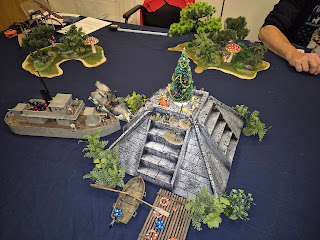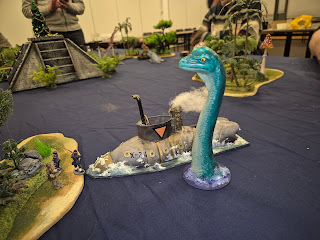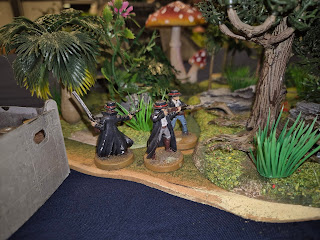For our club's annual Christmas Battle we revisted Bog A Ten, a venerable demo game by the good people of the HLBSC. Some brilliantly self-built boats there !
Monday, December 23, 2024
Bog-A-Ten Revisited: the 2024 Christmas Battle
Sunday, November 17, 2024
Tercios in Warlords' Pike & Shotte
I have played Warlord's Pike & Shotte rules lots of times. But the way the interaction of the pike and shotte units is handled by the rules always seemed somewhat generic to me.
This is of course partly caused by the fact these units interacted with each other in numerous different ways, depending on -for example- the exact period of time and nationality of the armies.
Nowhere is this more apparent than in the later years of the Dutch Revolt or, as we Dutch prefer to call it: the Eighty Years War. Because in this period the classical Spanish tercios clashed with the (then) modern Dutch Battallions which led to an especially spectacular result in the Battle of Nieuwpoort in 1600.
We have played Nieuwpoort a number of times and the way the differences between the tercios and the Dutch battalions was portrayed never sat well with me.
 |
| Our Nieuwpoort table in 10mm. |
The P&S rules state (p29) that a Tercio has a large number of pike in the center and large and deep sleeves of shot on the flanks. Battallions are formed from smaller units of pike in the center and shallow and wider sleeves of shot on the flanks. But the rules offer no more more than this formation suggestion. How tercios and battalions behave is up to the players.
So I ventured to think of a better way.
The Spanish Tercio
Tercios as a battle formation were at the time over a century old. They grew out of the need to defend themselves against shock cavalry which requiered big (between 2000 and 3000 men) and dense formations armed with pike to repel- and supporting infantry armed with projectile weapons to counterattack cavalry. Around 1600 Tercios employed pike and shot in about a 3 to 2 ratio, although sources state that at Nieuwpoort it was actually nearly 1 on 1.
 |
| Contemporary ilustration of the Spanish main force at Nieuwpoort. |
Against other infantry the dense pike formation could gain tremendous momentum and push opponents out of its way.
Of course such maneuvers requiered drill and discipline to move in such a large formatrion in the first place. Maneuvers would never be fast, but at least the formation was strong and could fight in any direction.
On the other hand, they were very vulnerable to another modern weapon: artillery. To withstand that, tercios had to be extremely resilient. So tercios would have to be large, strong, multi-fronted and resilient. But should also pay the price for this by being slow and have to concentrate firepower on a relatively narrow front. Also, shotte units should be requiered not to stray too far from the pike block as to prtect themselves from cavalry.
The Dutch Battalion
History tells us that the Dutch Battalion as introduced by Maurits in the late 1500s was very different. First they were much smaller than the tercios; between 500 and 750 men. The Dutch army was split up in many battallions, while a Spanish army was usually made up of just a few tercios.
Battallions were extremely well drilled and could maneuver much faster and more flexible, bringing their firepower to bear where desired. While a battalion's front was narrow, their maneuverability enabled them to cover each other's flanks and widen the front where their firepower could be brought to bear. And just like a tercio they could seek cover in bastion formations with shotte covering beneath or behind the pikes.
So in a one-on-one fight against a tercio their odds were slim. But being able to concentrate their fire and evade direct contact they could wear down a tercio until cavalry could finish the job.
So, how could this translate into rules?
Special
rules Tercio
- A tercio is a combined formation made up of one Large or Very Large (see below) pike block and 4 Small or Standard shotte units.
- The Tercio may form hedgehog.
- All 5 units move within the following restraints:
- The shotte always maintains contact with the pike block unless broken, disordered or shaken. This means staying within at least Support distance.
- When separated the separated unit is obliged to seek contact with the pike block before all else.
- The shotte may move around the pike block. For example to form a hedgehog formation, facilitate close combat for the pikes or relocate firepower.
- Otherwise the 5 units move as one.
- The units support each other. A breaking unit may thus trigger more break tests.
- The units may be targeted, take hits and casualties individually and also make break tests individually.
- The Tercio counts as one target for targeting purposes. As long as a shooting unit has line of sight to a unit that is a part of the Tercio, that unit may be fired upon, disregarding the rules about closest target.
- Spanish Tercios are Elite 4+.
Very Large Formation: 10 Hand-to-hand, Stamina 6
Special rules Dutch
Battallion
- A formation consisting of a Standard pike block and a Standard shotte unit.
- The shotte unit may join in front or behind the pike block or split up and be positioned as sleeves. In all cases they operate as a Standard shotte unit.
- The Battallion may form hedgehog.
- The shotte always maintains contact with the pike block unless broken, disordered or shaken. This means staying within at least Support distance.
- When separated the separated unit is obliged to seek contact with the pike block before all else.
- The shotte may move around the pike block. For example to form a hedgehog formation, facilitate close combat for the pikes or relocate firepower.
- Otherwise the 2 units move as one.
- The units support each other. A breaking unit may thus trigger more break tests.
- The units may be targeted, take hits and casualties individually and also make break tests individually.
- Dutch Battlions are Superbly Drilled.















































